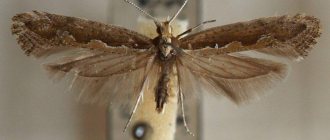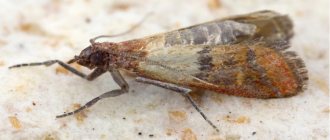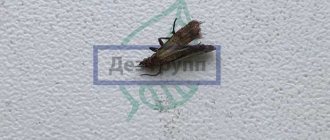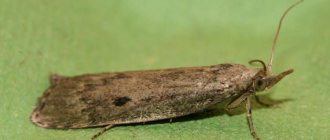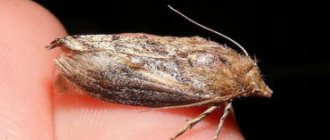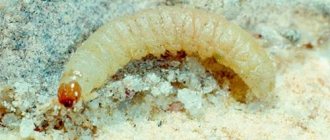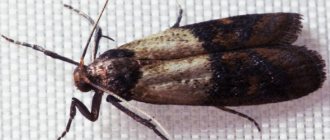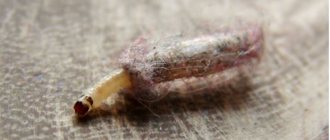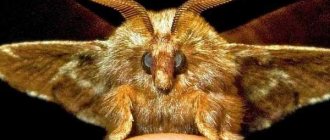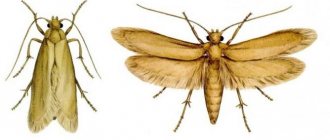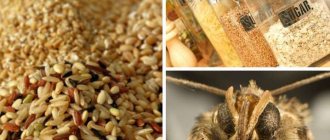When moths appear, many begin to worry about their property stored in closets. Therefore, the question is often asked: what do moths eat? Everyone knows that the pest in the house or apartment definitely does not eat potatoes (although there is also a potato moth, but this is not a domestic species), but the question of what it feeds on is appropriate and timely, as it will help save clothes, including a mink coat.
Where do food moths come from, what does it look like, what does it eat, how long does it live?
Some people are very familiar with such an insect as the food moth. This moth can be of different sizes and visually it resembles a small butterfly.
IMPORTANT: Although most moths look the same, they have their own characteristics, depending on the species.
Whatever type of moth you have in your house, it requires mandatory removal. Simple aerosols will not help here. First of all, food may suffer from this (if you make large supplies). Any poisons are also prohibited (their remains can then be mixed with food).
Food moth butterfly starts in the kitchen
to recognize the larvae and caterpillars of food moths - they all look the same. Their length, as a rule, does not exceed one to one and a half centimeters . The color of the caterpillars is white , milky, yellow, beige (light). Pink caterpillars are less common.
In appearance, the caterpillar is absolutely smooth , without fibers or antennae. The caterpillars actively eat groceries, where, in fact, their nest is located. They need active nutrition for growth and development.
Most often, caterpillars do not want to “attract attention to themselves” and hide in groceries, but before pupating (transforming into a butterfly), they often crawl onto walls and any surfaces.
Caterpillar of food moth, found in food
It is important to know that food moth multiplies very quickly. If the atmosphere (humidity, temperature) is favorable for the insect, it immediately lays eggs.
Moths are capable of laying eggs every six weeks (from one to one and a half hundred eggs). The butterfly tries to lay eggs where they can feed and survive - for human food . A room temperature of 20-25 degrees has a beneficial effect on moth eggs and promotes their rapid development.
It is interesting to know that it is the moth caterpillar that destroys grocery supplies. The butterfly does not feed at all. She lacks a complete digestive system. An adult moth lives no more than a month (maximum one and a half months).
Food moths lay eggs in human food.
The laid larvae eat literally everything that they can encounter:
- Any cereals: millet, semolina, buckwheat, wheat
- Cereals: oatmeal, bran, seeds
- Bread , cookies, flour, crackers
- Whole grain
- Cocoa, spices (not spicy)
- Sugar
- Any nuts : walnuts, peanuts, almonds
- Dried fruits : dried apricots, prunes, figs, raisins
Each type of food moth has its own food preferences, but in order to survive they eat absolutely everything (this is often what happens in apartments). it is very difficult to get them out completely the first time .
The bad thing is that in addition to the fact that the larva feeds on human products, it weaves a cocoon around the area around itself. As a result, the food is covered with a thin silk web and looks like lumps. If the nest starts in nuts, the moth forms small nests on their surface.
IMPORTANT: Food moths do not enter the house from neighbors, nor from the street. A person himself introduces insect larvae with low-quality cereals and purchases from a store (often a mass producer does not carefully check his workshops and barns for the presence of moths). The harm caused by food moths is enormous. It spoils food and makes it impossible to eat.
Food moths in bread, cereals, dried fruits, cereals
Prevention of occurrence
Food moth
If moth-like butterflies fly around the house, then most likely the owner of the apartment has forgotten about methods to prevent the reproduction of this insect. Having studied where moths come from in an apartment, it is not difficult to remember the simplest preventive measures.
First of all, you need to inspect products only brought from the store. It is quite possible to find larvae in rice or bugs in buckwheat as a “surprise” in a bag of cereal. If nothing is found there, then it is better to pour the products intended for storage into glass jars or dry canvas bags soaked in a concentrated saline solution. You can periodically wipe the shelves with vinegar, and place lavender in the kitchen cabinet. You should not store large supplies of food in your apartment that could harbor insects.
Clothes moth
Prevention of the spread of clothes moths in the house consists mainly of a thorough inspection of all newly purchased items. The front side of the item, the back side, all seams and folds are carefully examined. If no insect larvae or pupae are found on the item, then it is recommended to keep the item on the balcony in the fresh air and sun, just in case.
For the purpose of prevention, you can hang homemade sachets with lavender in the closet, lay out tobacco leaves, or use ready-made aerosols, sections, plates or bottles with aromatic oils.
If moths appear on fur products in the house, then first of all it is necessary to treat them with any modern insecticidal preparation, which is presented in a large assortment in stores. If such a problem occurs in winter, it is recommended to additionally keep the item in the cold. The insect cannot tolerate frost. Air temperatures below 10 degrees are detrimental to all species at any stage of development. Small objects can be dried on a radiator; hot air also destroys moths. A good preventative measure is to periodically ventilate cabinets.
The moth is an omnivorous insect that adapts well to human conditions.
Having figured out where the moth is coming from, you can prevent it from entering your apartment, since it is always easier to prevent its appearance than to fight this insect.
The moth is an inconspicuous gray butterfly that is primarily nocturnal. In nature, there are several hundred species of this insect. Some of them prefer to live in human homes, turning into malicious pests. Their favorite foods are furs, woolen products, and food products. To find out how to deal with this insect, you need to know where the moth comes from, what types of this pest inhabit our houses and apartments, as well as the characteristics of reproduction.
Do food moths eat clothes and what kind?
The food moth is capable of destroying huge human food reserves , but this insect does not touch clothing . Such a butterfly is not dangerous for the wardrobe. However, you should not relax, because clothes moths can also live together with food moths . This moth is visually very similar to a food butterfly.
Often, in the struggle to remove food moths, people do not pay attention to clothes moths. Food moths also do not lay larvae in clothing, and the larvae do not harm fur, sheepskin, cotton and other types of fabric.
Food moths do not harm human clothing at all
Is this parasite dangerous for humans?
Unlike other various parasitic insects, moths do not cause much harm to a person and his apartment if it is removed from the house in time. This moth often destroys only certain clothes.
Certain types of moths (for example, the cereal moth) damage food products such as cereals, chocolate and nuts. However, this type of moth does not cause significant harm to humans.
Why are moths dangerous?
It harms a person in the following ways:
- spoils the appearance of food;
- contaminates dishes;
- destroys clothes;
- causes discomfort.
Such a lepidopteran parasite is dangerous to human health only if he does not get rid of it in a timely manner.
Moths in the kitchen: how to find a nest
In order to remove a moth, first of all, you should find its nest . Of course, this insect is not as unpleasant as a cockroach, but it can cause a lot of harm.
The moth nest is the very place where the maximum number of butterfly caterpillars are concentrated. Visually, the nest , if formed in cereals or flour, resembles lumps and pellets. Pieces of cereals or groceries are shrouded in silken webs. Between the lumps there are larvae. The walls and surface of the dish in which the cereal is located are strewn with white caterpillars.
A moth nest can be placed in a cereal package
Pay attention to where exactly you meet moths most often:
- On the shelves where cereals are stored
- In the bread bin
- In the spice box
- In a bag of sugar, in a bag of flour and so on
If you find a nest in your grocery store , carefully check each package of cereal and pasta. But the best thing is to throw out absolutely all supplies in order to definitely kill the insect. Even one or two larvae can contribute to the reproduction of moths in the future.
Food moths nest in human food
How to get rid of food moths in the kitchen in products: remedies
You should kill the moth when you find a nest of larvae or caterpillars. Of course, butterflies should also be killed, because they are capable of laying about a hundred eggs. Only comprehensive removal of insects can completely rid you of the problem.
Moths should be destroyed starting from the nest:
- If you find a nest in food, you should throw out all the food from the drawer, cabinet, or cabinet. Do not try to leave anything behind; an egg or larva may be laid in any product.
- If you want to preserve visually undamaged food, you need to either heat it in the oven (no more than 60 degrees for about half an hour) or freeze it overnight . This way you will preserve the product and completely kill the insect.
- Completely empty furniture of food. Treat cabinets with special anti-moth sprays. Leave the furniture in this condition for several days (during this time you can sort out the food). After this, thoroughly wash the cabinets with soapy water . Return processed foods to their place.
- You can get rid of moths using special adhesive tapes. The insect lands on the tape and is no longer able to move, and therefore live. In addition, such tape can be saturated with poison.
If you treat furniture with a chemical, try to avoid even the slightest contact with food. Otherwise, you may get severe poisoning.
Sticky tape that can get rid of moths
What is this pest?
The common moth looks like a relatively small and completely harmless butterfly. However, in addition to adult individuals, there are also larvae that are consumers of keratin, easily obtained from wool fibers, carpet pile and fur coats. They leave behind waste products that clog the “former lunch spots.”
Of course, not a single face can completely destroy a carpet or fur coat, but the thing will still be damaged, since several rather large holes will appear in it. Those who study what moths eat are sure that in one day each individual is capable of chewing through a woolen or wool-blend product.
How to remove food and fruit moths from the kitchen using folk remedies?
If you do not want to use chemicals to get rid of moths, you should use traditional methods. In action are:
- Plants with a strong aroma
- Dried herbs
- Fruits: fresh and dry
- Essential oil
- Technical means
Each of these remedies is effective in its own way. They are good because they are perfectly able to fit into the atmosphere of an ordinary city apartment. But the disadvantage of each remedy is that it can have an effect of varying strength, sometimes weak.
Household moth repellents:
- Mothproof sections. These are special products that are filled with substances that are loved by moths, but also poisonous to them. This section has the appearance of a hook, which is convenient to hang in any furniture. This product is not mass produced and is rarely found on sale.
- An unfavorable atmosphere for its reproduction will help the lime moth For example, food moths are afraid of bright light (which is why they breed inside cabinets) or humidity. As a preventive measure, you can periodically open the doors in the cabinets or take the food out to the balcony to “ventilate”. The larvae are not able to live in such conditions and die underdeveloped.
- anti-moth tablets will also help You can buy them in the household chemicals department. The principle is simple: you put a poisonous pill in a cabinet, which emits an unpleasant odor and a substance that causes the insect to die.
A reliable remedy is tablets for moths.
Folk remedies for food moths are plants:
- Lavender is a popular folk remedy that has been tested for centuries. The strong smell of grass and inflorescences “scares off” moths and “drives” them away from the place where you place the bunch.
- Tansy, wormwood - also effectively repels moths with a strong aroma. The advantage of tansy is that other insects hatch along with moths: ants, spiders, beetles
- Rosemary and dill are aromatic herbs that can “drive away” moths. The downside of rosemary is that it quickly loses its strong scent. The grass should be constantly changed, every few days.
- Geranium – moths do not like the smell of geranium, but only fresh leaves or flowers
Lavender is an effective remedy for any moth.
Other available remedies that can get rid of moths:
- Orange peel is a good remedy that can kill food moths. It is worth knowing that fresh peel is effective. Therefore, you need to add aromatic citrus peel as often as possible.
- Essential oil - has a strong aroma that moths simply cannot stand. It is best to use patchouli, lemongrass, rosemary or fir oil.
- Vinegar is an effective and radical way to combat moths. This product can remove moths from the kitchen, since moths are really “afraid” of it.
- Laundry soap - this product acts on the principle of household moth repellent tablets and can “scare off” insects.
- Chestnut - for this purpose, chestnut fruits collected in September and October should be spread over all the furniture in the kitchen.
Orange peel is an effective moth repellent
Features of reproduction
An insect that finds itself in a living room or has occupied crops begins to actively reproduce. This process takes place in four stages. First, the female lays eggs. They can be collected in one place or scattered throughout the area, which will later be occupied by parasites.
Those who do not know what moths eat will be interested in the fact that during the development and growth of the caterpillars, the previous generation of pests gradually dies out. This explains the noticeable decline in the number of flying butterflies.
Actively feeding larvae begin to increase in size. A well-fed individual pupates and spends about two months in its cocoon. After this period, a moth appears from there, looking like a chaotically flying butterfly.
If eggs are laid in early autumn, the larvae have to overwinter in woven cocoons. Individuals found inside living quarters continue to feed intensively, while all others hibernate until spring arrives. It should be noted that not all varieties of flying parasites are able to withstand winter frosts. With the onset of warmth, butterflies emerge from the cocoons, which, in turn, begin to reproduce their offspring.
How to get rid of food moths forever?
Only a thorough check of all the products you bring into the house, as well as moth prevention, will help you get rid of food moths . If you purchase cereal in a store or supermarket, take the time to carefully examine the packaging. Even under a layer of polyethylene you can see the corpses of moths or larvae.
TIP: Buy only high-quality groceries from well-known manufacturers. As a rule, such products differ not only in taste, but also in quality.
Regularly inspect your bins , sort out the grains, ventilate the cabinets. It is useful to wash furniture outside and inside once a month with a solution of laundry soap and vinegar.
Cleaning the kitchen and washing out cabinets is an effective prevention against moths
